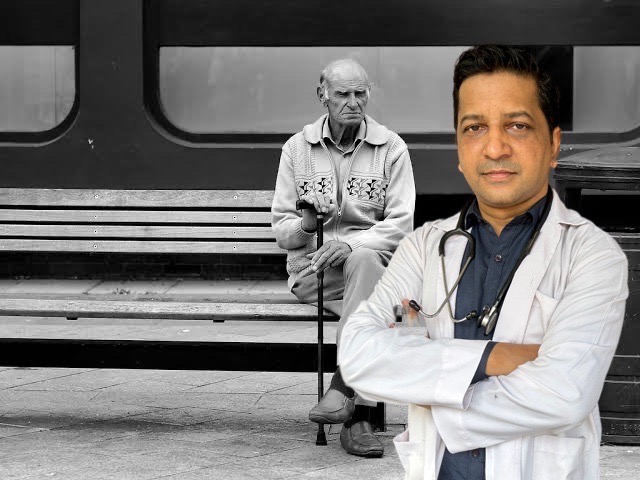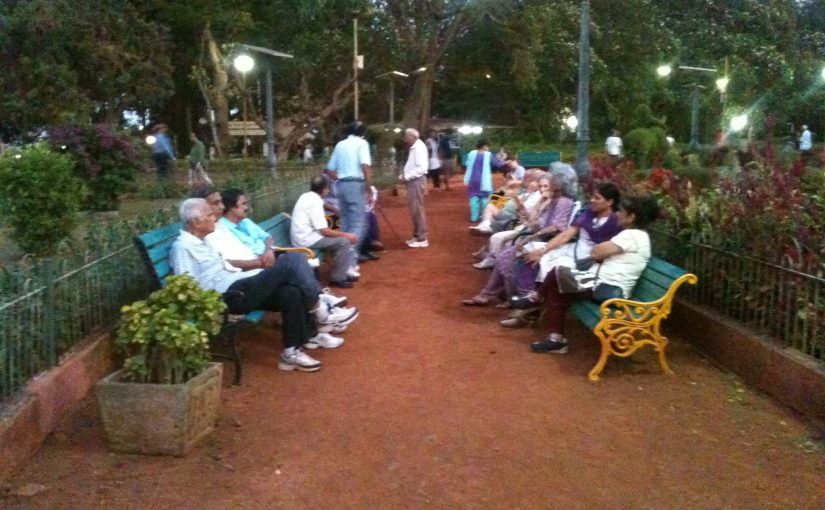Gardens have become popular places for the people to bond and catch up with one another’s news…. makes for less loneliness and ill health.
In light of the report on “Loneliness & Isolation’ released by the US Surgeon General this week, the Goan Observer spoke to DR AMIT DIAS of the Department of Preventive Medicine, GMC, to get a better understanding of how loneliness impacts senior citizens. Chronic loneliness and social isolation increases the chances of developing diseases like depression, dementia and also lead to premature death.
Q: Doctor, how would you define loneliness?
A: I don’t think I can do justice in trying to define the term in words. I would like to start with a very heart-wrenching statement I heard from someone I always admire as a “jewel” of India, namely Sir Ratan Tata. At a recent functions I heard him say “You do not know what it is to be LONELY.” That emotional statement by someone like him, says it all. I will not try to define loneliness for you. It means much more than not having anyone around you. Worse still, you can also be lonely when you have someone around you and this feeling is even more devastating. Humans are social animals and we need to belong somewhere.
Q: What are the implications of loneliness for seniors?
A: Being lonely is something many seniors experience and fear. During my research on aging and care in Goa many seniors confided that they feel that they have become irrelevant and no one cares about whether they are dead or alive. Few call even to say hello or to talk, so seniors feel they are half-dead instead of reasonably alive and active. Seniors feel they are just existing and not living.
They are also worried about being dependent on others even if it family members.
The document released by Dr. Vivek Murthy, the US Surgeon General this week titled, “Our Epidemic of Loneliness & Isolation” serves as an eye-opener and is not only relevant to the US but to the rest of us as well. The report highlights that around 50% of adults state that they have experienced loneliness. The prevalence for loneliness and isolation was higher in people with poor physical or mental health, disabilities, financial insecurity, those who live alone, single parents, as well as younger and older people.
The impact of loneliness is much more in the elderly. I read an interesting study from the University of California on “Super Agers” — defined as people above the age of 80 years, who have the mental agility of people much younger. They all had one thing in common — they all had FRIENDS and stayed connected.

Q: What are the key findings of the report?
A: The report states that loneliness is the new risk factor for several diseases. It can not only cause depression and anxiety and lead to suicide but may be responsible for cardiovascular disease, stroke, dementia and other afflictions. Interestingly, believe it or not, the report highlights that loneliness has the same negative impact on your life as smoking 15 cigarettes per day!! Loneliness can increase the risk of premature death by 30%.
Chronic loneliness and social isolation can increase the risk of developing dementia by approximately 50% in older adults. The involvement and support of family members have a positive impact on disease management and the health of people with diabetes.
The report highlighted that loneliness or social disconnect is a continuum. We often tend to look at it as a dichotomous variable — it’s either there or not. But we need to start thinking of it as a gradient. Everyone falls somewhere on the continuum of social connection. Loneliness and low social connection are generally associated with poorer outcomes of health.
Q: Are these findings surprising?
A: Not very surprising. We have been noticing the impact of loneliness on health in our country as well. The report comes as a wake-up call to all of us at every level to put our act together and do something about it.
Q: How relevant are these findings to our country?
A: We are facing the same problem — we may be at a different level of the continuum of social connection. Our country is undergoing a rapid demographic transition and the aging segment is growing very fast in tune with the rapid developments in the standard of living, health care, nutrition and sanitation. However, we have a situation, where the younger population have migrated to the cities, metros, or other countries for better job opportunities while their parents are left alone in their village. We call it the PICA syndrome — parents in India, children abroad, which has brought with it the problem of difficulties in care arrangements.
This is becoming very obvious in our state of Goa, which has a high proportion of elders living alone. Elders are often left alone and have to manage with remote control help or no help at all. We also have a lot of elders without children or family support, who struggle with their health and day-to-day management. Simple tasks sometimes become a nightmare and they chose to carry on with life by ignoring their health and nutritional needs. To make matters worse, the Covid-19 pandemic and lockdowns further aggravated situations at home and imposed social isolation for an extended period.
Q: What are the recommendations of the report?
A: The report suggests Six Pillars to Advance Social Connection:
Pillar 1: Strengthen social infrastructure (like parks and clubs) in local communities
Pillar 2: Enact pro-connection public policies
Pillar 3: Mobilize the health sector to understand the problem
Pillar 4: Reform digital environments
Pillar 5: Deepen our knowledge
Pillar 6: Cultivate a culture of connection
To start, we need to understand loneliness to be a risk factor for disease and find solutions from within our resources to reach out to those in need of our help and cultivate a culture of connection.
Q: What is your message to our readers?
A: Start by asking the question: Do you know the names of your neighbors? Will you be able to recognize them if you met them in the market? If not, then start by getting to know them. Cultivating social capital and cohesion in the community is a key step. Everyone wants to belong somewhere. Your family may not be the only option. You need to plan your life and network to develop a social support system. Various options are now available. It may take some effort, but it will pay in the long run. The government and policymakers also have a major role to play. There are solutions to the problem from within the system.
I started with a quote from Sir Ratan Tata and I will end with a quote from him — “If you want to walk fast, walk alone…but if you want to walk FAR, walk together.”
